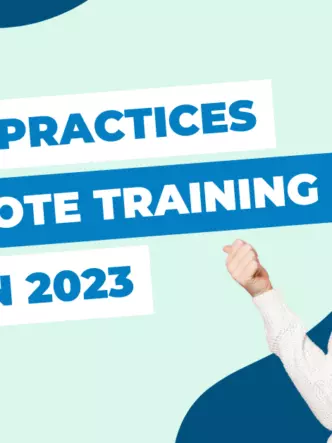Remember the times when you could just walk into a meeting room, conduct a brainstorming session with your team and leave the room with some great ideas?
It’s safe to say that, owing to COVID-19, that’s not happening anytime soon.
Online brainstorming sessions have been found to increase creative output by almost 50%, compared to in-person ones. But let’s face it: virtual brainstorming sessions are not easy to manage. It is also not easy to manage the work of the employees themselves, but for this, fortunately, they came up with monitor remote desktop activity so that the employer is aware of what his subordinates are doing.
From people talking over each other and increased distractions to interfering background noise and technical glitches, online brainstorming, if not managed properly, can lead to a colossal waste of time.
How do you replicate in-person brainstorming sessions remotely while abiding by the rules of brainstorming and making valuable use of everyone’s time?

Let’s take a look at how you can run effective virtual brainstorming sessions with your remote team.
1. Share the brainstorming brief in advance
The process of coming up with ideas on the spot sounds great. However, you don’t have an infinite amount of time in which to let your creative juices flow.
In order to make the best use of your team’s time, it’s advisable to prepare a brainstorming brief and share it with participants well in advance.
The idea behind sharing a brief is to ensure everyone fully understands the goal of the brainstorming meeting or the problem you’re trying to address. That way, team members come prepared with their ideas and questions.
The brainstorming brief can include details such as:
- Date
- Participants involved
- Duration
- The purpose of the brainstorming session
- Background information on the problem you’re trying to solve
- Links to research material such as survey data, competitor information, etc.
- List of brainstorming questions that encourage people to think in a particular direction
Make sure the discussion is focused on a specific pain point as opposed to trying to cover everything at once. This will help you generate rapid ideas and get more done as a team.

2. Use brainstorming maps
Brainstorming is a collaborative activity; maintaining a spreadsheet or having everyone make their points in silos certainly won’t cut it.
One of the most effective ways to generate, organize and group ideas is by using a visual tool such as brainstorming maps.
Create a mind map that lets you visualize ideas and provide structure, helping the team get an overview of all the ideas shared over the course of the brainstorming session.
You can also use different colors and icons to make associations and segment ideas.
The goal of the brainstorming session serves as the starting point and is entered in the center of the mind map while each branch represents different ideas.
Here’s an example of a brainstorm bubble map that illustrates the popular forms of marketing content. The first set of nodes represent forms of marketing content while the second set of nodes explain the use case or popularity level of each kind of marketing content.

3. Conduct it over a video call
What’s better: sharing your ideas and having a blank screen stare back at you or making eye-contact and watching someone nod while you speak?
It’s most probably the latter.
A huge part of brainstorming relies on in-person interaction, social connection and spontaneous team collaboration.
But how do you establish rapport when you’re separated by a screen?
By conducting brainstorming sessions over a video meeting, facilitated by video conferencing solutions.
As per a Forbes Insight report, 97% of executives agree that video conferencing improves the sense of connectedness among remote workers.
That’s not all, video conferencing also creates a more authentic experience while keeping team members engaged and energized.
You can use tools such as Zoom, RingCentral or Microsoft Teams to conduct effective brainstorming sessions over a video call and drive deeper levels of understanding in the process.

4. Appoint a moderator
In a remote environment, the chances of a brainstorming session turning into a regular online meeting are very high.
This is why it’s important to appoint a moderator or facilitator whose job should be to provide direction, bring structure to the session and keep track of time.
A moderated brainstorming session generates quality results, makes better use of people’s time and is a lot more productive.
As the manager or team lead, you can choose to moderate the session yourself or assign another team member to take charge. When using a video conferencing solution, such as Zoom, the role of the moderator will fall to the meeting’s host. He or she can decide to mute certain participants (it’s always recommended to do that as a last resort😉) and even end the meeting if things get out of hand.

5. Regularly check-in with all participants
Almost every team has a few people who have ideas to share but are overshadowed by the more “loud” participants.
Kellogg professor and author, Leigh Thompson articulates this well when she says, “the dominant people begin to feel that the silent people are unprepared or simply don’t have any opinions, so they dominate more; similarly, the quiet folks feel that it is futile to try to be heard, so they stop trying.”
Unfortunately, the virtual setup does not help this situation; it makes it more difficult to break into conversations, resulting in participants feeling left out.
How do you avoid such a scenario?
The key is to regularly check-in with all participants by asking them questions or getting their feedback. This ensures that everyone is given the opportunity to share their thoughts and isn’t left feeling isolated.

6. End with action steps
Have there been times when you’ve attended a brainstorming session that had ideas pouring in but once the session ended, none of those ideas came to fruition?
That’s a mistake you should avoid.
Whether you’re ideating your next fundraising event or coming up with social media contest ideas, every brainstorming session ought to end with an action plan. Every team member needs to leave knowing the next steps and what’s expected of him or her.
At the end of the virtual brainstorming session, ensure you define the action steps and set clear expectations. You can use project management software to document it and track progress.
It’s also a good idea to use visual communication and provide your team with a visual action plan, helping everyone interpret and retain the information with ease. It can serve as a reference point for future communication.
Here’s an example of an action plan template you can use. Notice how it uses icons and colors to emphasize points and differentiate information:

Final thoughts and takeaways
While nothing can replace face-to-face communication, virtual brainstorming sessions, when approached with productive goals and solid preparation, can prove to be as effective as in-person ones; if not more.
These best practices will help you run meaningful and engaging brainstorming sessions with your remote workers while making valuable use of time.









